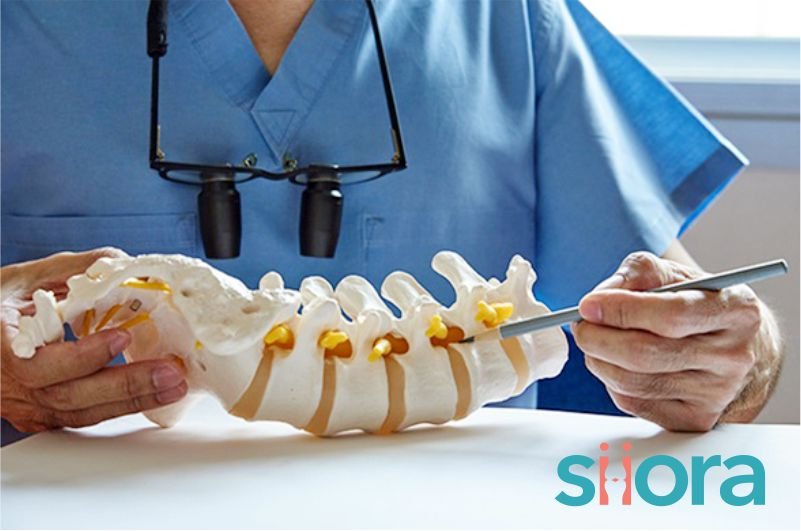Lumbar spine surgery is the technique of correcting deformities, defects, and diseases in the lower back. There could be multiple reasons why an orthopedic specialist recommends this surgery. This post will talk about lumbar spine surgery in detail along with its procedure and reasons.
What is Lumbar Spine Surgery?
Lumbar spine surgery is a surgical technique by which a spine surgeon manipulates vertebrae present in the lower back to provide relief from back pain, inflammation, and other symptoms. An orthopedic spine surgeon recommends this surgery when conventional non-surgical treatments fail to improve severe lower back pain after trying for 6-12 weeks.
When it comes to having lumbar spine surgery, it is always the decision of the patient whether to go for it or not. However, there are rare cases where immediate surgery is a must to improve back pain.
Why is Lumbar Surgery Performed?
Surgery is always the last treatment option until the condition is severe enough to require immediate surgery. Lower back pain has become a common problem in the elderly as well as young adults. The reason for such an issue is a poor lifestyle, especially in the younger generation. However, in adults, lower back pain is a common problem because of aging. With age, our spine deteriorates, and this causes pain in the lower back. It directly affects our daily lives, and, in some cases, the person becomes unable to even walk or stand.
The goal of lumbar spine surgery is to improve lower back pain that does not respond to conventional non-surgical treatments. Some of the causes of lower back pain that may demand surgery include:
- Herniated disc
- Spinal stenosis
- Scoliosis
- Rheumatic disease
- Spinal infection
- Osteoporosis
- Spinal tumors
- Fractures
- Muscular imbalance
These are some of the spinal problems that may demand surgery for treatment.
What Are the Types of Lumbar Surgery?
Lumbar spine surgery is a general term, the orthopedic surgeon decides the type of surgery required depending on the cause of pain. Two types of lumbar spine surgeries are there:
- Lumbar Decompression
- Lumbar Fusion
Lumbar Decompression Surgery
Lumbar decompression surgery aims at treating compressed nerves in the lower back. This surgery is recommended when non-surgical methods fail to improve associated symptoms like persistent pain and numbness. The surgery involves cutting a small part of the bone pressing the nerve or a portion of the spinal disc below the nerve. Here, the goal is to maintain enough space for the nerve to pass through the bony canal. Thus, this helps improve symptoms associated with the condition. Two of the common conditions for which decompression surgery is feasible are lumbar spinal stenosis and lumbar herniated disc.
When it comes to performing lumbar decompression surgery, there are two common types:
- Microdiscectomy
- Laminectomy
Microdiscectomy
Microdiscectomy is a minimally invasive surgery that is often a choice option for treating herniated discs in the lumbar spine. It involves removing some part of the herniated disc to relieve pressure on the spinal nerve column. Microdiscectomy is advantageous over other lumber spine surgeries in several ways. It ensures long-term success with the treatment of a herniated disc along with better recovery.
Microdiscectomy can help when the pain with sciatica persists for over 12 weeks even after trying non-surgical methods. The surgery aims at removing the disc material which is pressing onto the nerve. Before starting surgery, the surgeon will give general anesthesia to the patient.
Laminectomy
Spinal arthritis is the condition for which the orthopedic surgeon recommends laminectomy. The surgical procedure involves removing bone spurs and soft tissues causing compression in the spinal canal. Laminectomy involves removing a small portion of the lamina (the back part of the vertebra in the spine). This enlarges the space in the spinal canal while relieving the pressure off the nerve.
Bone spurs often develop in people suffering from spinal arthritis and this puts pressure on spinal nerves by reducing the space in the spinal canal. So, this surgery is recommended when conservative treatments like medication, physiotherapy, or injections fail or when the symptoms are getting worse.

Lumbar Fusion Surgery
Another option for lumbar spine surgery is lumbar fusion. This surgery involves fusing the problematic segment of the vertebrae to improve painful motion in the lower back. Two of the common spinal conditions for which the orthopedic surgeon may recommend lumbar fusion surgery are degenerative disc disease and spondylolisthesis.
The surgeon uses a bone graft for fusing vertebrae. This surgery stops any movement of the fused spinal segment but provides relief from pain and disability caused by the spinal condition.
Lumbar fusion surgery involves the use of spinal implants and instruments. Some of the common reasons why spinal fusion is recommended include:
- Reshaping the spine
- Improving spinal instability or weakness
- Treat damaged spinal disc
- Sacroiliac joint dysfunction
Lumbar fusion surgery can be performed in several ways i.e., from the back (posterior approach), the front (anterior approach), the side (lateral approach), or a combination of two or more.
If we talk about the alternative to lumbar fusion surgery, then disc replacement is the best.
Post-Operative Care After Spine Surgery
The success of lumbar spine surgery depends a lot on post-surgical care. Once the surgery is complete, the spinal surgeon will guide you on what to do after the surgery. Here are some of the instructions that you may need to follow:
- Avoid any strenuous activities that put pressure on the operated area for the period as advised
- Physical activity must be performed as suggested by the doctor
- Keep the surgical incision dry and clean as per the surgeon’s instructions
- Avoid bathing for at least 48 hours after surgery and do not soak the incision
- Avoid scratching the surgical site as itching is common
- Do not drive until the surgeon clears you to drive
- Do not miss appointments and tell if you are experiencing anything unusual after the surgery
- Focus on having a healthy diet
- Avoid smoking and alcohol consumption as it could delay recovery
Following these instructions will ensure a quick and better recovery after the surgery. However, if you have any doubts in your mind, you can consult the surgeon.
Siora Surgicals Pvt. Ltd. is a world-class manufacturer of a CE-certified range of orthopedic implants and instruments including spinal implants. All the products that the company manufactures uses medical-grade stainless steel and titanium. Besides this, they also pass stringent quality checks before being approved fit for use. Siora owns a well-established manufacturing facility in the RAI District, Sonepat, Haryana, and is also known as an experienced OEM/contract manufacturing service provider across the globe.







